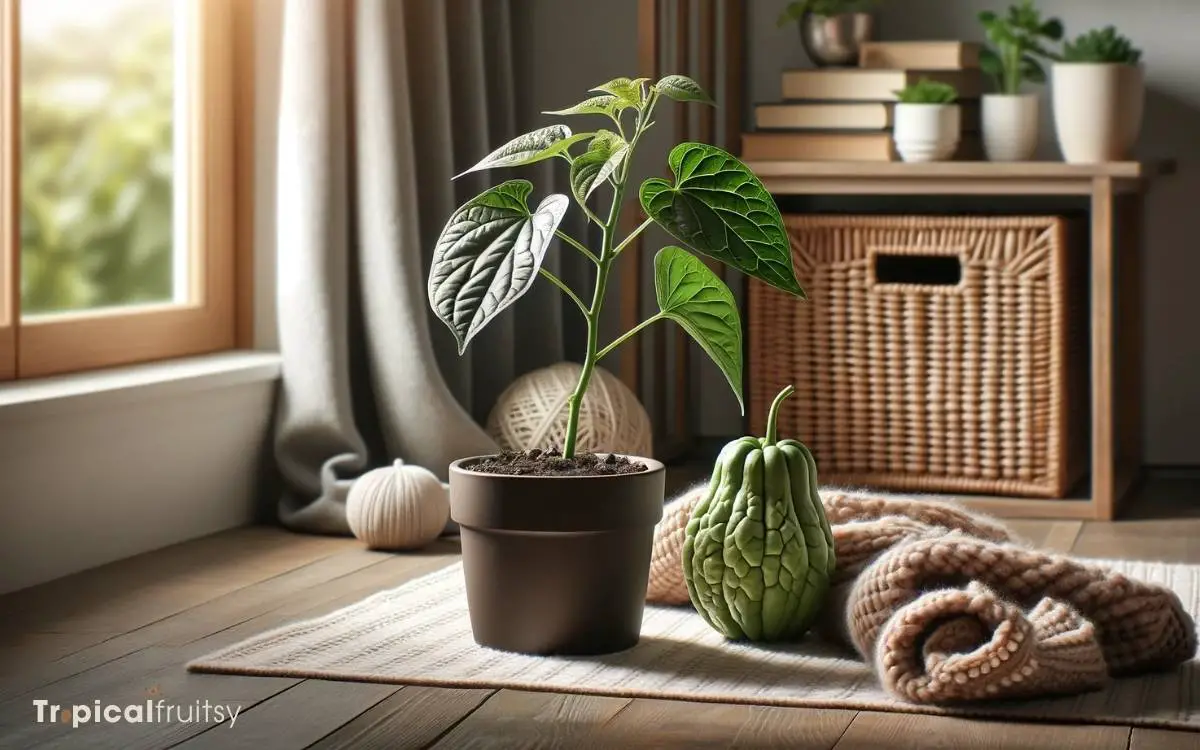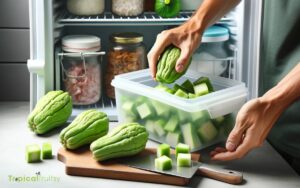Can You Grow Chayote Indoors? Yes!
Yes, you can grow chayote indoors with the right conditions, including sufficient light, a large pot, and regular watering.
Chayote (Sechium edule), also known as vegetable pear, is a warm-season climbing vine that is typically grown outdoors. However, you can cultivate chayote indoors if you provide a suitable environment.
Here’s how you can achieve this:
Growing chayote indoors can be a rewarding experience, offering a touch of the tropics right in your home.

Key Takeaway
Understanding Chayote Basics
We often overlook the chayote, a versatile and resilient member of the gourd family, when considering indoor gardening options.
Native to Central America, this pear-shaped squash, also known as mirliton or chocho, thrives in warm climates but can adapt to less ideal conditions.
We’ll find that the chayote isn’t only nutritious, packed with vitamin C and amino acids, but also remarkably easy to cultivate.
To grow chayote indoors, we need a bright spot and patience, as the vine requires ample light and time to mature. It’s crucial we provide a sturdy trellis for support, considering its climbing nature.
With its ability to yield a bountiful harvest from a single fruit, chayote is a practical and rewarding choice for our indoor gardens.
Choosing the Right Container
While considering the chayote’s climbing nature, it’s essential to select a container that’s deep enough to accommodate its root system and ensure healthy growth.
We’ve found that a pot with a minimum depth of 12 inches works best, providing ample space for the roots to spread out. Remember, a sturdy container is also crucial given the chayote’s size as it matures.
Here are key points to consider when selecting your container:
- Depth and Width: Choose a pot at least 12-18 inches deep and equally wide.
- Material: Opt for clay or plastic with good drainage.
- Support Structure: Ensure the pot can support a trellis or stake for the vine to climb.
Adhering to these guidelines will help your indoor chayote thrive.
Soil and Nutrient Requirements
Chayote’s soil should be rich in organic matter and well-draining to support its vigorous growth. We recommend a soil mixture that combines garden soil, compost, and either perlite or sand to improve drainage.
This ensures that the roots have access to the necessary air and water without becoming waterlogged, which can lead to root rot.
For nutrients, a balanced, slow-release fertilizer works well. We apply it according to the package instructions, typically at the beginning of the growing season and then again midway through.
Chayote plants aren’t heavy feeders, but they do appreciate consistent nutrition to produce their best fruit.
Ideal Indoor Lighting Conditions
Our indoor chayote plants need bright, indirect sunlight for at least 6 to 8 hours a day to flourish.
Achieving this can be a bit tricky indoors, but here’s how we make sure our chayote gets the light it needs:
- Position plants near a south-facing window, where they can bask in gentle yet ample light.
- Utilize grow lights, especially during winter months, to supplement natural sunlight.
- Rotate the plant regularly to ensure equal light distribution and prevent leaning.
Proper lighting is crucial for photosynthesis, growth, and fruit production. Without it, our plants won’t produce the vigorous vines and delicious fruit we’re aiming for.
Watering Your Chayote Plant
How do we ensure our indoor chayote plant receives the right amount of water without overdoing it? The key is to maintain consistent moisture without allowing the soil to become waterlogged. We should check the top inch of soil; if it’s dry, it’s time to water.
Typically, watering once a week suffices, but this can vary depending on air humidity and temperature.
It’s crucial to use a pot with good drainage and to avoid letting the plant sit in standing water, which can lead to root rot.
We also need to be mindful of the water quality; chayote prefers rainwater or filtered water to avoid the build-up of salts.
As we manage our plant’s hydration, we also need to consider the importance of maintaining proper temperature.
Maintaining Proper Temperature
We must maintain an optimal temperature range for chayote plants to thrive indoors, typically between 70-80°F. Exploring heat source options, such as grow lights or heating mats, can help us keep the environment consistent.
We’ll also discuss reliable temperature monitoring methods to ensure our chayote receives the warmth it needs without guesswork.
Optimal Temperature Range
While growing chayote indoors, it’s crucial to maintain a temperature range between 70-80°F (21-27°C) for optimal growth.
Chayote, being a tropical plant, thrives in this warm environment, which closely mimics its natural habitat.
To ensure we’re providing the best conditions for our indoor chayote plants, let’s keep in mind the following:
- Consistent warmth is key; fluctuations can stress the plant.
- Avoid cold drafts which can shock the plant and stunt growth.
- Monitor with a thermometer to keep the temperature within the ideal range.
By carefully managing indoor temperatures, we give our chayote the stable environment it needs to flourish.
Heat Source Options
To maintain the necessary warmth for our chayote plants, let’s explore several effective heat sources that can be used indoors.
One reliable option is using heating mats specifically designed for plant cultivation. These mats gently warm the roots, promoting healthy growth without overheating.
We can also consider adjustable heat lamps that provide both light and warmth, simulating natural sunlight conditions.
For a more integrated solution, radiant floor heating systems can offer consistent temperature control throughout the room. It’s crucial we monitor the heat output, ensuring it remains within the optimal temperature range for chayote.
A thermostat connected to the heat source can help us maintain the precise environment our plants need to thrive indoors.
Temperature Monitoring Methods
Ensuring our chayote plants flourish, we’ll need to implement effective temperature monitoring methods to maintain the proper warmth they require.
It’s critical to create an environment where these tropical natives can thrive, especially indoors where temperature fluctuations are common.
Here are three reliable methods:
- Thermometers and Hygrometers: These tools provide accurate readings of the ambient temperature and humidity, essential for adjusting heating sources accordingly.
- Thermostatic Controls: Connected to heating equipment, they allow for automatic temperature regulation, maintaining a consistent climate for the chayote.
- Digital Monitoring Systems: Advanced systems can offer real-time data and alerts to smartphones, ensuring we can respond quickly to any temperature changes.
Pruning and Harvesting Tips
We’ll need to regularly prune our indoor chayote vines to encourage healthy growth and successful harvests.
Pruning involves selectively removing parts of the plant to improve structure, increase air circulation, and prevent disease. It’s best to prune when the vine is actively growing.
For chayote, focus on cutting away dead or diseased stems and any overcrowded areas. This ensures the plant directs energy to producing fruit rather than sustaining unnecessary foliage.
When it comes to harvesting, you’ll want to wait until the chayotes are about four to eight inches in size and have firm skin. Gently twist and pull the fruit from the vine to avoid damaging the plant.
With the right care, we can enjoy a bounty of fresh chayotes right from our indoor garden.
Conclusion
In wrapping up, we’ve seen that growing chayote indoors is quite doable with the right know-how. Haven’t we all dreamed of plucking fresh veggies right from our windowsill?
With a suitable container, proper soil mix, and adequate light, we can nurture our chayote vines indoors. Remember, consistent watering, warm temperatures, and regular pruning will be key to our success.
Let’s get our hands dirty and enjoy the fruitful rewards of our indoor gardening efforts!






